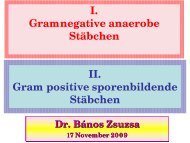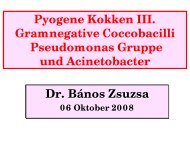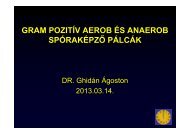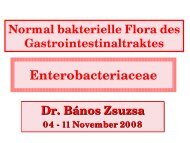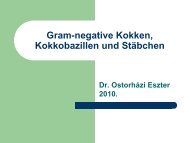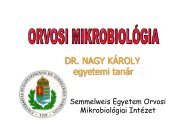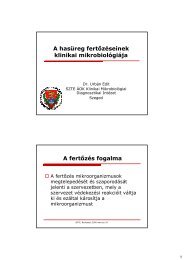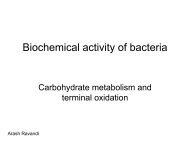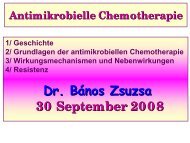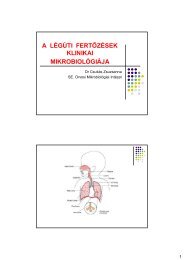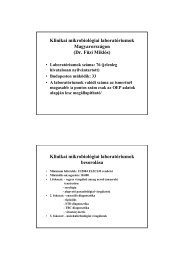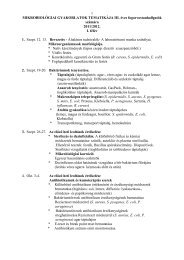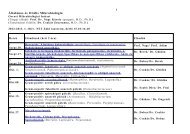Gram positive spore-forming rods
Gram positive spore-forming rods
Gram positive spore-forming rods
You also want an ePaper? Increase the reach of your titles
YUMPU automatically turns print PDFs into web optimized ePapers that Google loves.
GRAM POSITIVE SPORE-FORMING<br />
SPORE FORMING<br />
RODS<br />
NON-SPORE NON SPORE FORMING OBLIGATE<br />
ANAEROBIC BACTERIA AND<br />
ASSOCIATED INFECTIONS<br />
JOSEPH ONGRÁDI ONGR DI<br />
INSTITUTE OF MEDICAL MICROBIOLOGY<br />
SEMMELWEIS UNIVERSITY<br />
Budapest 2012
ALLOCATED IN SEVERAL TAXONOMIC UNITS<br />
HERE: FUNCTIONAL GROUPINGS<br />
GRAM POSITIVE<br />
SPORE-FORMING RODS<br />
CLOSTRIDIUM GENUS<br />
ONLY!!!<br />
NON-SPORE FORMING<br />
ANAEROBIC BACTERIA<br />
<strong>Gram</strong> + cocci and<br />
<strong>rods</strong><br />
<strong>Gram</strong> – cocci and<br />
<strong>rods</strong><br />
COMMON CHARASTERISTICS<br />
CATABOLISM: ANAEROBIC (fermentation)<br />
lack of the cytochrom system, superoxide dismutase,<br />
catalase and peroxidase enzymes<br />
TOXIC END PRODUCTS OF OXYGEN METABOLISM<br />
OBLIGATE ANAEROBIC --------- AEROTOLERANT<br />
SPECIMEN COLLECTION: transport media without O 2<br />
CULTIVATION: removal of O 2 (GasPack, etc.)
GRAM POSITIVE<br />
SPORE-FORMING RODS<br />
Exogenous infections<br />
1 species = 1 disease<br />
Small number of species<br />
more clinical entities<br />
Varied pathomechanisms,<br />
but molecularly well<br />
characterized<br />
Diagnosis: unambigous<br />
Treatment: unambigous<br />
Prevention: unambigous<br />
DISTINCT CHARACTERISTICS<br />
NON-SPORE FORMING<br />
ANAEROBIC BACTERIA<br />
Endogenous infections<br />
Many species<br />
Mixed infections: (polymicrobial)<br />
more aerobic +<br />
anaerobic species<br />
<br />
similar clinical entities<br />
Diagnosis: complicated<br />
Treatment: difficult<br />
Prevention: difficult<br />
3
ENDOSPORE: ENSURES SURVIVAL<br />
PRODUCED IN THE ENVIRONMENT (SOIL, WATER, AIR)<br />
EXTREME RESISTANCE<br />
(PARAMETERS AND BIOLOGICAL MONITORING OF STERILIZATION PROCEDURES)<br />
Bacillus genus<br />
Aerobic<br />
Spore Ø < bacterium Ø<br />
B. anthracis (flagella-, capsule+)<br />
B. cereus (flagella+, capsule-)<br />
enterotoxins: (food poisoning)<br />
heat stabile: emetic<br />
heat labile: diarrhoea<br />
eye, wound infections, IVDA<br />
B. subtilis: contaminant ,<br />
bioterrorism model<br />
B. megaterium: contaminant<br />
B. mesentericus: contaminant<br />
B. stearothermophilus, B. pumilis:<br />
monitoring sterilization procedures<br />
B. globigii: modelling bioterrorisms<br />
Other Bacilii: insecticides<br />
Clostridium genus<br />
Obligate anaerobic<br />
Spore Ø > bacterium Ø<br />
Peritrichous flagella<br />
(capsule: C. perfringens)<br />
Exogenous infections<br />
Endogenous: C. perfringens<br />
C. difficile<br />
Intensive metabolism,<br />
gas production +/-<br />
Neurotoxic (exotoxin):<br />
C. tetani (non- invasive)<br />
C. botulinum (toxicosis)<br />
Histotoxic (invasive):<br />
C. perfringens + C. septicum +<br />
C. novyi + other<br />
Enteral (nosocomial):<br />
C. difficile (dysbacteriosis) 4
MORPHOLOGY: 5-10 µm x 1 µm<br />
Square ends<br />
Capsule (in host), central <strong>spore</strong><br />
(in nature)<br />
CULTIVATION:<br />
agar/bloodagar: medusa head<br />
lecithinase (weak)<br />
PATHOGENIESIS: cattle, sheep><br />
feces/carcasses>soil>saprophytic ><br />
<strong>spore</strong>s persist for decades in dry earth><br />
human infection<br />
Capsule+exotoxin (protective antigen,<br />
edema factor, lethal factor)<br />
CLINICAL FINDINGS:<br />
Skin anthrax:<br />
animal products , scratch,wound, ><br />
12-24 h latency> gelation edema><br />
malignant pustule>necrotic ulcer><br />
bacteremia>sepsis<br />
Inhalation anthrax:<br />
hemorrhagic lobular pneumonia,<br />
edema>meningitis, sepsis, shock<br />
„woolsorter's disease”<br />
biological warfare (bioterrorism)<br />
Intestinal anthrax: abdominal pain,<br />
bloody diarrhea, vomiting, ascites
Intestinal<br />
anthrax<br />
Cutaneous anthrax<br />
Respitarory anthrax
DIAGNOSIS:<br />
Specimens: fluid or pus from pustules<br />
blood, sputum, feces<br />
staining, immunofluorescent staining<br />
cultivation on blood agar<br />
(no hemolysis, no swarming)<br />
Serology: precipitation, hemagglutination<br />
to detect animal or human antibodies<br />
Ascoli test: immune serum + tissue extract<br />
Animal infection: guinea pig and<br />
mouse – sensitive, rat – resistant<br />
PREVENTION: public health control measures<br />
deep burial in lime-pits<br />
autoclaving animal products<br />
protective clothing<br />
Vaccination: live attenuated vaccine for animals<br />
humans (occupational risk): cell-free vaccine<br />
TREATMENT: as early as possible!<br />
penicillin (except in inhalation anthrax)<br />
tetracyclin, erythromycin, clindamycin<br />
7
WHAT IS BIOTERRORISM?<br />
A BIOTERRORIST ATTACK IS<br />
THE DELIBERATE RELEASE OF BACTERIA, VIRUSES, OTHER GERMS<br />
OR TOXINS TO CAUSE ILLNESS, DEATH, DISRUPTION OR FEAR<br />
IN HUMANS, LIVESTOCK, FOOD CROPS AND ENVIRONMENTAL<br />
RESOURCES<br />
39 MAJOR MICROORGANISMS AND BIOLOGICALS TO BE USED<br />
(NATO categorization)<br />
RECENT DEVELOPMENT:<br />
corrosive microbes to destroy electric appliances, health care products,<br />
gaskets<br />
THE MOST LIKELY, PREDICTED METHOD OF NEXT BIOLOGICAL ATTACKS:<br />
AEROSOLIZED AGENTS<br />
8
CHARACTERISTICS OF BIOTERRORIST ATTACKS<br />
SUDDEN AND UNEXPECTED ONSET<br />
LARGE NUMBER OF CASES<br />
TYPICAL, ATYPICAL OR UNKNOWN CLINICAL ENTITIES<br />
THE EFFECT: DEADLY (SMALLPOX)<br />
INCAPACITIVE, TEMPORARY (Q-FEVER)<br />
SPREAD: CONTAGIOUS (PLAGUE)<br />
NON-CONTAGIOUS (TOXINS)<br />
THE FATE OF AFFECTED PERSONS: CURABLE (ANTHRAX)<br />
INCURABLE (EBOLA)<br />
SPREAD OF THE AGENT: aerosol (
BIOTERRORISM AGENT CATEGORIZATION<br />
CATEGORIZATION<br />
HOW EASILY THEY ARE TO OBTAIN, WEAPONIZE,<br />
DISSEMINATE<br />
HOW MUCH DEATH, THE SEVERITY OF ILLNESS<br />
HOW MUCH DAMAGE, DISRUPTION OR FEAR THEY<br />
MIGHT CAUSE<br />
10
CATEGORY A<br />
High priority agents (organisms, toxins) that pose<br />
the highest risk to the public security:<br />
easy spread or transmitted from person to person<br />
high death rate, major public health impact<br />
cause public panic, social disruption<br />
require special action for public health preparedness<br />
Variola major<br />
Bacillus anthracis<br />
Clostridium botulinum (toxin)<br />
Yersinia pestis<br />
Francisella tularensis<br />
FILOVIRUSES (Ebola, Marburg viruses)<br />
ARENAVIRUSES (Lassa, Junin, Machupo)<br />
BUNYAVIRUSES (Crimean-fever, Rift-valley fever)<br />
11
THE MOST IMPORTANT MICROORGANISMS FOR<br />
BIOTERRORISM (II)<br />
CATEGORY B<br />
THE SECOND HIGHEST PRIORITY<br />
MODERATELY EASY TO SPREAD<br />
MODERATE ILLNESS RATES, LOW DEATH RATES<br />
REQUIRE SPECIFIC ENHANCEMENTS OF LABORATORY CAPACITY<br />
Brucella spp.<br />
Burkholderia mallei<br />
Burkholderia pseudomallei<br />
Rickettsia prowazekii<br />
Coxiella burnetti<br />
Chlamydia psittaci<br />
Alphaviruses (Venezuelan horse encephalitis)<br />
Staphylococcus aureus (enterotoxin B)<br />
Salmonella spp.<br />
Escherichia coli O57:H7<br />
Vibrio cholerae<br />
Shigella spp.<br />
Cryptosporidium parvum<br />
2010 SU Dept. Public Health 12
THE MOST IMPORTANT MICROORGANISMS<br />
FOR BIOTERRORISM (III)<br />
CATEGORY C<br />
EMERGING PATHOGENS THAT COULD BE ENGINEERED FOR THE FUTURE<br />
EASILY AVAILABLE<br />
EASILY PRODUCED AND SPREAD<br />
ATYPICAL OR NEW DISEASES<br />
POTENTIAL HIGH MORBIDITY AND MORTALITY RATES<br />
MAJOR HEALTH IMPACT<br />
NIPAH VIRUS, HANTA VIRUS<br />
RECOMBINANT MICROBES (bacteria, viruses, fungi)<br />
THE FUTURE<br />
ADAPTING ANIMAL VIRUSES TO HUMANS (Iraq: camel smallpox virus)<br />
ENHANCED PATHOGENICITY OF KNOWN MICROBES<br />
insertion of IL-4 gene into mouse pox virus to inhibit immune functions (Australia)<br />
Clostridium botulinum: to spread from person to person (Soviet Union)<br />
Bacillus anthracis: insertion of more virulence genes to circumvent vaccination<br />
(Soviet Union)<br />
recombination of Ebola and HIV (Soviet Union)<br />
insertion of antibiotic resistance genes to produce polyresistant bacteria (SU)<br />
2010 SU Dept. Public Health 13
RISK OF ANTHRAX INFECTION<br />
U.S. Postal Service distribution clerk Sheila Dickson-Ongrady uses gloves as she<br />
sorts mail in Hamilton Township, N.J., facility Tuesday. An employee of the<br />
facility is believed to have contracted inhalation anthrax (Laredo Morning<br />
Times).
Saprophyte in the soil<br />
MORPHOLOGY: flagella +, capsule –<br />
CULTIVATION: swarming, hemolysis on blood agar<br />
PATHOGENESIS:<br />
1. Enterotoxin>food poisoning, intoxication<br />
Emetic type (<strong>spore</strong>s: soiI>rice, pasta) Diarrheal type (meat)<br />
2. Other: eye infections (trauma, foreign body><br />
keratitis, end-, panophthalmitis) endocarditis, meningitis, osteomyelitis,<br />
pneumonia, IVDA<br />
OTHER BACILLI<br />
Parasites of insects < commercial insecticides<br />
Food poisoning?<br />
DIFFERENTIAL DIAGNOSIS: biochemistry, phage typization<br />
15
Tetanus (1888)<br />
MORPHOLOGY: 2-5 µm x 1-2 µm,<br />
flagella (specific antigen), terminal <strong>spore</strong><br />
CULTIVATION: obligate anaerobic<br />
β-hemolysis on blood agar<br />
PATHOGENESIS: 1884<br />
EXOTOXIN=tetanospasmin (151 kD, A-B-C chains)<br />
Released by bacteriolysis. Minimal wound>necroparasite>non invasive<br />
germination and toxin production is aided by associated pyogenic infection,<br />
calcium salts reducing oxidation-reduction potential<br />
Toxin absorption in neurons>retrograde axonal transport to CNS ><br />
circulation>fixed to gangliosides> postsynaptic inhibition of acetylcholine<br />
inhibitory factor>generalized muscular spasms, hyperreflexia, seizures<br />
=TOXEMIA<br />
(tetanolysin=exotoxin, non pathogenic)<br />
16
TETANUS<br />
Opisthotonus<br />
Trismus<br />
Risus sardonicus Neonatal tetanus
CLINICAL FINDINGS:<br />
5-7 days of latency>spasms><br />
convulsive tonic contraction of voluntary muscles><br />
lockjaw, hydrophobia, opisthotonus, interference with<br />
mechanics of respiration>death. Fully conscious!<br />
INFECTION: soil, horse stool (occupational disease),<br />
<strong>spore</strong>s in air<br />
wounds, uterus, umbilical stump (90% in developing<br />
countries), abortion, burns<br />
iatrogenic: surgery, ointments, catgut, injections<br />
mortality: 50-60%, 1 M cases/year worldwide<br />
DIFFERENTIAL DIAGNOSIS: rabies, strychnin poisoning
TREATMENT:<br />
1.Symptomatic: proper care of wounds, surgical debridement (no<br />
hyperbaric oxygen) muscle relactants, sedation (external stimuli<br />
precipitate tetanic seizures), assisted ventilation<br />
2.Toxoid recall injection<br />
toxoid + antitoxin iv. (earlier horse serum,<br />
recently human serum: tetanus immunoglobulin, HTIG)<br />
3. Antitoxin: before toxin becomes fixed onto nerves<br />
4.Antibiotics (penicillin, tetracyclin to stop toxin production)<br />
treatment of associated pyogenic infection<br />
PREVENTION: toxoid - active immunization<br />
DPT combination (childhood)<br />
recall injections in every 10 years (toxoid 0.5 ml)<br />
totally preventable, immunization is mandatory<br />
Booster shot in the elderly population would be ideal!
SAPROPHYTE BACTERIA (SOIL, INTESTINAL TRACT, DUNG)<br />
MORPHOLOGY: 7-8 µm x 1-2 µm, <strong>Gram</strong>+<br />
<strong>spore</strong> Ø > bacterium Ø<br />
Germination into bacterium > sporulation<br />
C. perfringens: capsule<br />
Peritrichous flagella: C. novyi, C. septicum,<br />
C. histiolyticum, C. sporogenes,<br />
C. tertium, C. bifermentans, C. fallax, C. sordelli, etc.<br />
(90 species/20 human pathogens)<br />
CULTIVATION: anaerobic, gas production<br />
(aerotolerants: milk stormy fermentation, clot torn)<br />
ANTIGENS: 12 types<br />
BIOCHEMISTRY: 1. Toxins: α, β, …,τ<br />
(α=lecithinase, LD 50 =50 ng, hemolysing, cell lysing, cardiotoxic<br />
inhibition by antitoxin: Nagler-reaction)<br />
toxinogenic strains: A-E<br />
2. Enzymes: collagenase, hyaluronidase, proteinase, DNase, etc.<br />
20
PATHOGENESIS: normal habitat in the gut (skin, vagina) flora<br />
Pathogenical local effects = tissue necrosis:<br />
1. >endogenous infections: Colon surgery, colon-carcinoma,<br />
appendicitis>perforation,<br />
uterus war, trauma, iatrogenic<br />
foul-smelling discharge, edema malignum,<br />
gas-phlegmone.<br />
myositis: edema,myonecrosis,exsudate,rapid progression, crepitation (acetylene,<br />
H 2 , etc), cellulitis<br />
General effects = toxic: malaise, hypotonia, fever, vomiting, nervousity,<br />
toxemia, shock, death.<br />
21
GAS GANGRENE
3. Bacteremia (10-15%): death<br />
4. C. perfr. "A" (C,D): food poisoning, meat dishes high protein content<br />
protects bacteria form strong acidic pH<br />
incubation: 9-15 h<br />
symptomps: abdominal cramps, diarrhea<br />
DIAGNOSIS: microscopy,<br />
cultivation (chopped meat-glucose medium,<br />
egg yolk medium),<br />
biochemistry, gas chromatography,<br />
toxin-neutralization (VERO-cells)<br />
phage typization, DNA-probes<br />
TREATMENT:<br />
1. ANTITOXIN<br />
(polyvalent: C. perfringens, C. septicum, C. novyi)<br />
to detoxity patients rapidly<br />
2. Antibiotics (penicillin, chloramphenicol, erythromycin,<br />
tetracyclin). Metronidazol<br />
3. Symptomatic care<br />
promt and extensive surgical debridement,<br />
hyperbaric oxygen<br />
early amputation<br />
PREVENTION: Cleansing of contaminated wounds<br />
24
Pseudomembranous colitis<br />
Iatrogenic: antibiotic-associated diarrhea<br />
MORPHOLOGY: <strong>spore</strong>s<br />
CULTIVATION: obligate anaerobic. Resistant.<br />
PATHOGENESIS: in normal flora (3% of adults)<br />
colonization: in newborns<br />
in adults during hospitalization from the hand of<br />
personnel, endoscopes, devices<br />
NON INVASIVE (yes: newborns, neutropenia)<br />
TOXEMIA (plasmid, phage, regulation?)<br />
toxin A: 440-500 kD enterotoxin (watery diarrhea)<br />
toxin B: 360-470 kD cytotoxic (colon wall destruction)<br />
Binding to gut wall: gradual > microabscesses ><br />
contraction > bleeding>necrosis>inflammation><br />
protein loss>watery/bloody diarrhea<br />
PROLONGED TREATMENT WITH ANTIBIOTICS<br />
(aminoglycosid, clindamycin) > dysbacteriosis > selection<br />
of resistant mutants > 4-9 days of incubation, abdominal<br />
pain > diarrhea, fever, elevated number of WBC<br />
(rarely: perforation, peritonitis, acute arthritis)<br />
26
CLINICAL DIAGNOSIS: endoscopy<br />
MICROBIOLOGICAL DIAGNOSIS:<br />
1. Cultivation<br />
(cycloserin, cefoxitin, fructose-agar, CCFA)<br />
2. Phage typization<br />
3. Toxin detection<br />
toxin B on VERO cells (24h CPE) and neutralisation<br />
toxin A detection: latex agglutination<br />
toxin A+B: ELISA<br />
PCR<br />
TREATMENT:<br />
1. Discontinuing administration of offending antibiotic<br />
2. Antibiotics: vancomycin, metronidazol, bacitracin<br />
3. Symptomatic: cholestyramin<br />
(=toxin B binding, but: binds vancomycin)<br />
4. Surgical (in case of perforation)<br />
PREVENTION: vancomycin in case of carriers and hospitalized patients<br />
medical personnel<br />
disinfection of medical devices, endoscopes:<br />
glutaraldehyde, Na-hypochlorite, iodine (sporocidal)<br />
wearing gloves during physical examinations by health care personnel 27
Saprophyte, ubiquiter in nature, (soil, dung vegetables, meat products)<br />
MORPHOLOGY: 3-8 µm x 1-2 µm, flagella, <strong>spore</strong><br />
CULTIVATION: blood agar, anaerobic<br />
ANTIGENS: common "O", type specific "H"<br />
EXOTOXINS: A-H (A, B, E /F/ human pathogenic)<br />
150-165 kD, 2 chains, disulfide bonds. Phage control.<br />
Heavy chain: binding to motor nerve endplates,<br />
internalization, light chain blocks acetylcholine release<br />
Extremely toxic: 1-2 µg lethal dose<br />
Heat labile: 100 o C, 20 min<br />
PATHOGENESIS: J. Kerner, 1820<br />
1.Botulism (botulus = sausage), food poisoning <strong>spore</strong> > food (canned,vacuum<br />
packed,smoked, spiced alkaline products, home canned vegetables) > germination ><br />
eaten w/o cooking/baking (20', 100C) > toxin absorption from gut (INTOXICATION)<br />
2.Spore > honey > colonization in infants>toxin production and absorption > poor<br />
feeding, weakness, floppy baby > sudden infant death syndrome (1976)<br />
Complete recovery<br />
3.Wound infection > toxin absorption (1943)<br />
EXOTOXIN in circulation > nerve endings > flaccid paralysis<br />
28
CLINICAL FINDINGS: 1-2h—1-2 days of latency,<br />
speech difficulty, double vision, inability to swallow,<br />
muscular weakness, +/- gastroenteritis,<br />
respiratory paralysis, cardiac arrest>no fever>death<br />
Fully conscious. High mortality (65>25%)<br />
Recovery without antitoxins in serum<br />
DIAGNOSIS:<br />
toxin detection:<br />
leftover food, vomiting, stool (infants), approx. for 1 month toxinneutralization:<br />
mouse injection, ELISA from sera: passive HA, RIA<br />
TREATMENT: 1. Polyvalent (A,B,E) antitoxin<br />
80.000 U horse serum: promtly administered<br />
2.Symptomatic: adequate ventilation (for 100 days!)<br />
3.Infants, wound infections: antibiotics (penicillin 10-20 MU/day)<br />
Contraindicated: tetracyclin, aminoglycosid (due to nerve toxicity)<br />
PREVENTION:<br />
1. strict regulation of commercial canning food hygiene<br />
2. home canning: boiling food for >20 min before consumption<br />
toxic food (beans, corn, peas, fish, vacuum-packed fish in plastic bags)<br />
spoiled, rancid, cans „swell”, innocuous appearance<br />
29
GENUS Species Biochemistry Residence<br />
<strong>Gram</strong> <strong>positive</strong> cocci<br />
Peptostreptococci 13 Protein hydrolysis/ Mouth, vagina<br />
Peptococci 1 utilization Mouth, respiratory tract,<br />
Anaerob streptococci 3<br />
vagina, skin<br />
<strong>Gram</strong> <strong>positive</strong> <strong>rods</strong><br />
Acids<br />
Propionibacteria 4 Propionic Skin, mouth, vagina<br />
Bifidobacteria 8 Acetic/lactic Gut, mouth, vagina<br />
Lactobacilli 56 Lactic Gut, mouth, vagina<br />
Actinomyces 20 +/- fermentation Gut, mouth, vagina<br />
Eubacteria 45 Butyric Gut, mouth, vagina<br />
Mobiluncus 2 Hydrolysis Vagina, rectum 30
<strong>Gram</strong> negative cocci<br />
GENUS Species Biochemistry/<br />
characteristc<br />
Residence<br />
Veilonella 3 Lactic acid Mouth, vagina<br />
Acidaminococci 1 Acetic/lactic acid Gut<br />
Megasphera 1 Capronic acid Gut<br />
<strong>Gram</strong> negative <strong>rods</strong><br />
Bacteriodes 18 Capsule Mouth, gut, vagina<br />
Prevotella 16 Pigment Mouth, vagina<br />
Porphyromonas 8 Pigment Mouth<br />
Fusobacterium 4 Polymorph Mouth, gut, vagina<br />
Leptotrichia 2 Elongated Mouth<br />
CONTINOUSLY CHANGING TAXONOMY: genera, number of species,<br />
new characteristics<br />
31
40 species pathogenic in human<br />
MICROBIOLOGY<br />
Obligate anaerobic ---------- microaerophil<br />
Moderate biochemical activity<br />
Protein hydrolisis<br />
Starch and carbohydrate fermentation:<br />
CO 2, foul-smelling gases<br />
32
Anaerobic streptococci:<br />
S. hansenii<br />
S. pleomorphus<br />
S. parvulus<br />
Residence:<br />
mainly respiratory tract (particularly the pharynx)<br />
Cultivation:<br />
non-hemolytic or alpha-hemolytic<br />
33
Peptostreptococcus micros<br />
resident in the normal mouth flora<br />
Produced diseases: periodontitis,<br />
abscesses around tooth implants(24%)<br />
hematogenic spread brain abscess<br />
chronic sinusitis in children, nasopharyngitis, otitis media<br />
retropharyngeal abscess, pulmonary abscess, erythema<br />
Peptostreptococcus anaerobius<br />
resident in normal mouth flora<br />
Produced diseases: as P. micros<br />
peritonitis appendicitis, diverticulitis, after abdominal surgery<br />
postpartum endometritis, septic abortion<br />
34
Peptococcus niger<br />
Produced diseases: postpartum endometritis,<br />
tuboovarial abscess<br />
septic abortion<br />
Coprococcus<br />
Ruminococcus<br />
Residents in the normal flora of human and animal<br />
Sarcina ventriculi<br />
Mostly in the gut flora of vegetarian people<br />
Unusual high number in the stomach: cancer<br />
Gaffkya<br />
Resident in the normal gut flora<br />
35
Pathomechanism:<br />
~ 15%- of normal flora<br />
Predominantly in dental plaques and periodontal pockets<br />
Continously changing resident flora in the mouth and gut<br />
Depending on age and nutrition (food habits)<br />
Polymicrobial (mixed) aerobic +<br />
anaerobic infection<br />
1. aerobic bacteria growth <br />
2. lack of normal oxygenization in tissues<br />
3. tissue destruction/necrosis, anaerobic conditions<br />
4. vast proliferation of anaerobic bacteria<br />
5. abscess formation, suppuration, gangrene, gas production<br />
36
Specimen collection:<br />
aspiration, punction<br />
Laboratory process:<br />
smears, staining<br />
Cultivation:<br />
usually small, grey colonies or other dark pigments<br />
no ideal selective media are available<br />
other microbes overgrow gram <strong>positive</strong> anaerobic cocci<br />
Identification at species level:<br />
no concensus protocol or scheme, uncertain<br />
carbohydrate fermentation, gas production<br />
enzyme reaction (urease, phosphatase, etc.)<br />
gas- liquid chromatography (GLC)<br />
Common end products: acetate, butyrate, capronic acid<br />
37
Penicillin resistance<br />
(due to the mutations of penicllin binding proteins)<br />
Resistance to metronidazole<br />
(mainly the microaerophilic species)<br />
Effective antibiotics:<br />
clindamycin (depending on geographical location)<br />
amoxicillin + clavulic acid<br />
4th generation quinolones (e.g. trova- and clinafloxacin)<br />
38
BACTEROIDES GENUS<br />
intensive sugar fermentation<br />
strictly anaerobic, very pleomorphic,<br />
non-motile<br />
polysaccharide capsule: B. fragilis<br />
no lipopolysaccharide endotoxin<br />
colonization: fimbriae<br />
Normal inhabitants of the upper respiratory tract, intestinal<br />
and female genital tract<br />
10 11 organism/g stool<br />
(B. caccae, B. merdae, etc.)<br />
Produced anaerobic infections:<br />
abdominal, brain, lung abcesses, empyema, PID<br />
surgical infections, peritonitis (pus: foul smelling)<br />
bacteremia endocarditis<br />
Taxonomical changes: Bacteroides melaninogenicus <br />
Porphyromonas gingivalis,<br />
Prevotella melaninogenica<br />
39
PORPHYROMONAS GENUS<br />
Porphyromonas gingivalis<br />
Oxygen tolerant, small black colonies<br />
on chocolate agar<br />
no carbohydrate fermentation,<br />
but proteolytic<br />
Porphyromonas endodontalis,<br />
P. asaccharolytica<br />
Residents of the normal mouth flora<br />
Produced diseases: soft tissue infection following<br />
human bites<br />
40
PREVOTELLA GENUS<br />
moderate carbohydrate fermentation<br />
glucose fermentation acid production<br />
saccharose fermentation!<br />
proteolysis<br />
pigment production<br />
P. intermedia, P. melaninogenica (B. melaninogenicus),<br />
P. denticola, P. loeschii<br />
residents in the normal mouth flora<br />
endogenous infections, inflammations<br />
periodontitis, surgical wound infection<br />
and abscesses<br />
41
FUSOBACTERIUM GENUS<br />
Pleomorphic <strong>rods</strong>, produce butyric acid<br />
Convert threonine to propionic acid<br />
Cystein, methionin: H 2 S production<br />
F. nucleatum**, F. alocis, F. sulci,<br />
F. necrophorum, F. periodonticum*<br />
** and * in the normal mouth flora, others in the gut<br />
** Prevotella/Porphyromonas coinfection<br />
Fusospirochetosis: noma<br />
Occassionally: Fusobacterium the only species<br />
in an infection (e.g. osteomyelitis)<br />
LEPTOTRICHIA GENUS<br />
Pleomorphic <strong>rods</strong><br />
First isolation: anaerobic,<br />
subcultures: elevate CO 2 level requirement<br />
L. buccalis: resident in the normal mouth flora<br />
in immunocompromised individuals: ulcerative gingivitis<br />
Frequent coinfection with Treponema, Porphyromonas,<br />
Fusobacterium species 42
Metronidazole (Klion)<br />
Amoxicillin + clavulic acid (Augmentin)<br />
Imipenem<br />
Chloramphenicol<br />
(severe side effects)<br />
43
Acne (carbunculus,phegmone,sepsis): Propionibacterium<br />
Skin (carbunculus): Eubacterium<br />
Chronic sinusitis: Peptostreptococcus, Eubacterium<br />
Post-maxillo-facial or periodontal surgery: Bacteroides,<br />
Fusobacterium, Porphyromonas, Prevotella, Actinomyces,<br />
Peptostreptococcus, Veilonella, Propionibacterium<br />
Gingivitis ulcerans: Leptotrichia, Porphyromonas,<br />
Fusobacterium (+Treponema)<br />
Peritonsillar abscess: Fusobacterium<br />
44
Brain abscess: Peptostreptococcus<br />
Pulmonary abscess, empyema: Bacteroides, Porphyromonas,<br />
Prevotella, Peptostreptococcus<br />
Thoracal infection: Actinomyces<br />
Hepatic- and perihepatic abscesses : Bacteroides<br />
Peritoneal infections, peritonitis, bowel rupture, post-surgical<br />
infection, war injury: Bacteroides fragilis, <strong>Gram</strong>+ anaerobic cocci,<br />
Actinomyces<br />
IUD in women, abscess, criminal (instrumental) abortus, salpyngitis,<br />
uterus abscess: Bacteroides, Fusobacterium,<br />
Peptostreptococcus, Mobiluncus<br />
Bacterial vaginosis: Mobiluncus, Porphyromonas,<br />
Prevotella, <strong>Gram</strong>+ anaerobic cocci (G.vaginalis)<br />
Perirectal abscess, fistule: Bacteroides, Fusobacterium<br />
45
Necrotising cellulitis in the limbs: gas gangrene clostridia<br />
Joint infections: <strong>Gram</strong>+ anaerobic cocci<br />
Leg ulcers: mixed infection (but: Clostridium)<br />
Bacteremia, septicemia, endocarditis:<br />
Bacteroides fragilis, Propionibacterium,<br />
Clostridium, Mobiluncus<br />
Infections in immunocompromised: Bifidobacterium,<br />
Lactobacillus<br />
46
LOCAL FACTORS<br />
ENDOGENOUS INFECTIONS<br />
dermal and mucosal wounds<br />
diminished tissue oxygenization<br />
(diabetes mellitus, angiopathy)<br />
surgery (oral, abdominal, gynecological)<br />
EXOGENOUS INFECTIONS<br />
human or animal bites<br />
SYMPTOMS<br />
foul-smelling pus, exsudate < fatty acids<br />
(diagnosis: gas chromatography)<br />
abscess formation, necrosis, gas production<br />
(differential diagnosis!)<br />
47
MODEL: VAGINA<br />
NEWBORN: sterile, colonization in few days<br />
SMALL CHILDREN: mixed flora (cocci, bacilli)<br />
FROM PUBERTY:<br />
1. Aerobic and anaerobic Lactobacilli (Döderlein)<br />
estrogen > glycogen fermentation of epithelial cells > lactic acid<br />
production > pH 4-4.5<br />
(~ treatment: 0.5% lactic acid)<br />
2. Resident flora: Bacteroides, Mobiluncus, <strong>Gram</strong>+ cocci,<br />
α-hemolysing streptococci, enterococci,<br />
Gardnerella , Mycoplasma, Ureaplasma, staphylococci, Mobiluncus,<br />
Candida species etc.<br />
3. Transient flora: Enterobacter, staphylococci, streptococci, clostridia<br />
Critical pH (preventing harmful microbes): 6.0-6.5<br />
Anaerobic : aerobic ratio: 2-5:1<br />
Sexual activity: individual and continously changing flora<br />
48
BACTERIAL VAGINOSIS<br />
Alterations in the ratio of the normal flora = dysbacteriosis ><br />
inflammation<br />
1. Decreased ratio of Lactobacilli in the flora<br />
2. Activation of endogenous bacteria = endogenous infection ><br />
increasing ratio > massive infection<br />
3. Promoting factors<br />
hormonal changes (age, menses, gravidity, oral contraception)<br />
chemical effects: antibiotics, chemotherapy<br />
mechanical effects: contraceptive barriers, IUD<br />
4. Consequences: pH increase (alkaline) ><br />
increasing ratio of all anaerobic bacteria (1000:1)<br />
>genital discharge> „amin vaginosis”<br />
>recurrent vaginal and urinary tract infections<br />
(10 9 /ml Mobiluncus, Prevotella, Porphyromonas, <strong>Gram</strong>+<br />
anaerob cocci, Myco-, Ureaplasma, Gardnerella, etc.)<br />
infection of the sexual partners (non-gonorrhoic urethritis)<br />
or the newborn at time of delivery<br />
DIAGNOSIS: clue cells, presence of PMNL, amin-test 49
In the majority of cases:<br />
mixed (aerobic + anaerobic) infection<br />
Surgical debridement,<br />
excision of all devitalized tissues<br />
50
THERAPY ANAEROBES<br />
<strong>Gram</strong> <strong>positive</strong> <strong>Gram</strong> negative<br />
Recommended<br />
without sensitivity test<br />
Recommended<br />
as determined<br />
by sensitivity tests<br />
Not<br />
recommended<br />
(resistant)<br />
β-lactam + β-lactamase inhibitors:<br />
e.g. Augmentin<br />
imipenem<br />
chloramphenicol<br />
clindamycin metronidazole<br />
tetracyclines<br />
erythromycins<br />
clindamycin<br />
cefoxitin<br />
moxalactam<br />
other β-lactams<br />
penicillines<br />
clindamycin metronidazole<br />
aminoglycosides<br />
fluoroquinolones<br />
51
www.bact.wisc.edu/Bact330/lectureanthrax<br />
www.cdc.gov<br />
52



